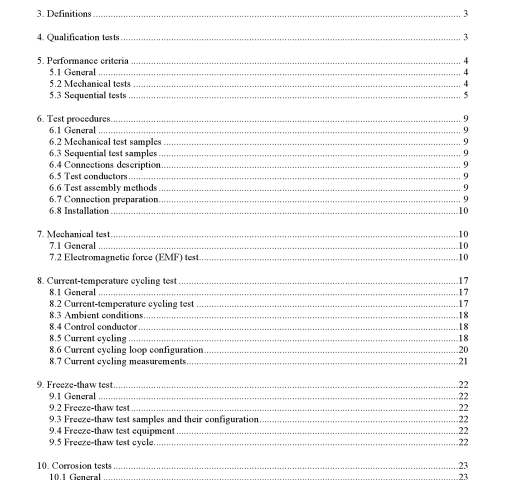IEEE 837-2014 pdf download.IEEE Standard for Qualifying Permanent Connections Used in Substation Grounding
4. Qualification tests
For qualification test sequence, refer to Annex D. Qualifications tests shall be performed for each family of connections, for example: (cable to cable straight connection, tap connection, cross connection), (cable to ground rod connection), (cable to lug connection), and (cable to structure connection). Qualification tests shall be performed for each style of connection. For example, crimped lug connections and lugs using bolted pressure plates to secure the cable are considered different styles. Therefore, both connectors are required to be tested to qualify the styles. Other examples of different connector design styles include cable to cable and cable-cross design styles. Within a family of connectors, more robust connectors need not be tested. For example, bolted pressure plate lugs using four (4) bolts need not be tested if two (2) bolts lugs have been tested successfully for the same size. Similarly, for a family of connectors tested for 4/0 AWG Copper or 19/#8 Copper Clad Steel (at 90% of fusing test current for the EMF test); smaller sizes may be qualified by passing only the initial resistance tests from 5.3.2.1.
For these smaller sizes, no other tests are required. However, connections for larger conductors specified in footnote b of Table 3 shall be tested for each size connection. When a connector design allows for a range of conductors, each of the tests outlined in Table 1 and Annex D must be performed on the “largest to largest” combination as well as the “largest to smallest”combination. Connectors shall be tested for all materials for which they are intended to be qualified per this standard. For example copper-clad steel conductors and connectors that are designed to be used on copper- bonded steel ground rods must be qualified by all of the tests in this standard. Several test parameters for connectors for use on 40% copper-clad steel conductors and copper-bonded steel ground rods are based upon electrical equivalency of copper conductors as listed in Table 5. The test parameters for conductors and ground rods not listed in Table 3 shall be calculated as per Annex C. A listing of the tests to be performed for all types of connections is given in Table 1. The connections shall be tested individually and sequentially, as shown in Table 1.
If during the testing, one of the four test samples fails, the testing must be discontinued. A group of four new samples from a different lot can then be retested. If one of the samples from the new group fails, the connector design does not meet the requirements of this standard and is considered as failed. This is applicable to all of the tests detailed in Table 1.
5. Performance criteria
5.1 General When installed and tested in accordance with this standard, all connections shall conform to the performance criteria given in 5.2 and 5.3.
5.2 Mechanical tests
5.2.1 Electromagnetic force (EMF) withstand criteria When tested in accordance with 7.2, the connector shall remain intact. The maximum allowable movement of the test conductor at each location shown in Figure 1 after two EMF surges shall not exceed either 10 mm or the outer diameter of the conductor, whichever is less (note in Figure 1, “X” illustrates what is meant by movement).
5.3 Sequential tests
5.3.1 Temperature criteria The temperature of the connections tested in accordance with Clause 8 shall not exceed the temperature of the control conductor.
5.3.2 Resistance criteria The resistance of the connection, calculated per 5.3.2.1 and tested in accordance with Clause 8, Clause 9, 10.1, 10.2, and Clause 11 for the salt spray sequence, and Clause 8, Clause 9, 10.1, 10.3, and Clause 11 for the acid sequence, shall not be greater than the specified values when compared to the initial resistance value. Resistance measurements shall be taken in accordance with 5.3.2.3. The resistance values shall be corrected to 20 °C.IEEE 837 pdf download.IEEE 837-2014 pdf download
IEEE 837-2014 pdf download

Leave a Reply